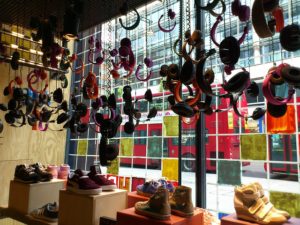 When it comes to visual merchandising, there are many challenges inherent in planning the layout, design, and elements to be included. There are several goals at play, such as grabbing attention and exposing consumers to as much merchandise as possible (without overwhelming them). Ultimately, you want your visual displays to create a positive customer experience, drive sales, and even encourage ongoing patronage.
When it comes to visual merchandising, there are many challenges inherent in planning the layout, design, and elements to be included. There are several goals at play, such as grabbing attention and exposing consumers to as much merchandise as possible (without overwhelming them). Ultimately, you want your visual displays to create a positive customer experience, drive sales, and even encourage ongoing patronage.
Naturally, it’s not easy to accomplish all of these goals with your displays and your overall visual merchandising strategy. Also, you’re likely to face several common challenges along the way. Here are just a few of the most pressing concerns you could encounter when planning your retail store layout and design.
Display Restrictions
How you display items could depend on the size of your store and the amount and variety of merchandise you have to display, but if you’re adept at managing inventory, chances are you’ll always have at least some overflow so you don’t run out of in-demand product. This can create a challenge as you try to decide what you’re going to display in limited space.
This is especially relevant if you experience a high turnover of goods, seasonal inventory updates, and the like, as many retail operations do. Finding the space to display items so you can market and sell them is one of the biggest ongoing issues many retailers come up against. Of course, another potential problem could actually provide a solution.
It’s not uncommon for retailers to overlook a certain empty area: overhead space. While this isn’t ideal for displaying goods, necessarily, it can be used for placement of signage or other eye-catching enhancements, freeing up space in floor-level to eye-level display areas for more consumer goods.
Product Flexibility Issues
Retailers often feature a variety of goods, some or all of which may come from different suppliers. Naturally, they all want the best placement for their products. They want them displayed at key locations in the layout (front of store or POS, for example) and they want them at eye-level for the greatest visibility. Agreements with suppliers can limit your ability to plan the visual merchandising setup you prefer.
The size of your space and product sizes, dimensions, and weights can also impact your visual merchandising plan as you may have limited options for placement of certain large or heavy items within your retail space. You can control this to some extent by tracking sales trends and using data to purchase the products that best suit your retail space and customer preferences. You could also leverage this data to negotiate placement or deals with suppliers. The best-selling, highest-earning products should receive preferential placement.
Budgetary Constraints
Visual merchandising includes more than products—it also encompasses signage and props, and even display tables, shelving, and so on. All of this will cost you, and if you change displays seasonally or even more often, you could have serious problems when it comes to budgeting for visual merchandising, especially if you can’t link commensurate earnings to your expenditures. Knowing your audience and getting creative with what you have on hand provides opportunities to cut costs and still mount displays that grab customer attention and drive sales.
If you are interested in purchasing display pedestals and showcases, shop our website, Specialty Store Services. We have everything you need. If you have a question that you would like answered immediately, you can Live Chat, or phone us at 800-999-0771.
